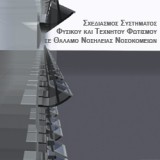Supervisor:
Architectural Technology
2008
The holistic approach to health and disease in combination with the rapid interest growth in sustainable design, which projects a holistic approach of the buildings design, constituted the base of the current research.
Subject for research is the design of a system with daylight and artificial light in a typical nursing ward of Papageorgiou hospital, in Thessaloniki.It is an external anidolic daylighting systemin combination withan internal light self. Anidolic systems (an-: without, -eidolon: image in ancient Greek) aim at an efficient collection and redistribution of the diffuse component of daylight to the back of a room. Anidolic systems use the optical properties of compound parabolic concentrators to collect daylight from the sky. Thisprocess becomes without losses because of the form of reflector.
Aim of the research, is the indication, not only of the importance of quantity, but also of quality, of daylight in a hospital nursing ward, as well as the proposal for particular system that will ensure it. Great emphasis is placed on the daylight’s distribution over the place, as well as on the influence that it exerts on the patient’s psychology and on his treatment accordingly.
At first, there is an introduction to the principles and strategies of daylight and its design difficulties. Then, subject for research is the mutual influence between man and environment, especially the way people react to colour and light, with regard to the psychological and physiological perspective too. Energy consumption of healthcare buildings and the prominence of the role of hospital environment in the patients’ nursing constitute a part of great importance in the research. In a following unit, there is concise presentation of the historical and morphological development of nursing homes’ and nursing wards’ design. The various facilities in health section are depicted in a variety of organizations and patterns.
Description of Papageorgiou hospital follows. There is presentation of the hospital’s function units, nursing wards and some constructional details. A questionnaire was arranged and distributed among the patients of the, under-study, nursing ward of Papageorgiou hospital. The questionnaire examined the patients’ point of view about the lighting conditions of the ward, the window size and the view that offers.
Taking into consideration the evaluations of the patients for the existent condition of the ward, a study takes place about the daylight conditions of the nursing ward, in three different occasions (conventional window - external light self – anidolic system) and there is evaluation of the suggested anidolic’s system function.
The artificial lighting system constitutes an essential element of a complete lighting design, for this reason there is presentation of general design calculations as well as presuppositions for the successful desing of an artificial lighting system in the nursing ward, as well as in rooms that surround th ward. Finally, research is placed on the application and performance of a specific luminaire in the nursing ward.
